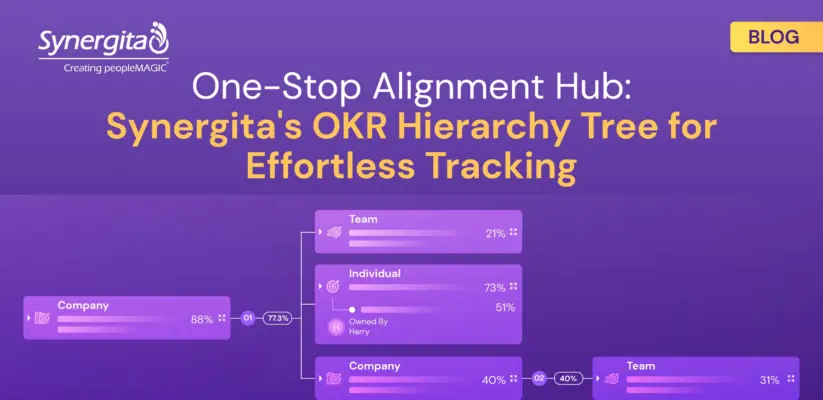One-Stop Alignment Hub: Synergita OKR Hierarchy Tree for Effortless Tracking
Introduction :
In the business world, where companies are chasing success and gearing up for unprecedented changes, 45% of organizations fall back due to the misalignment of goals across the organization. This puts them in the back seat, making success a dream come true. A few of the factors, such as technological advancement, the evolution of new skill sets, and more, contribute to the ambiguity and fear in employees, who will end up having a fear of not achieving their goals irrespective of industry type. This fear may lead to goal disparity, lack of clarity, misalignment, and more, paving the way to chaos. To overcome and nullify this chaos, it is very important to keep track of the progress and alignment of the goals.
This blog delves into the importance of goal alignment and its associated challenges. We will look at how Synergita OKR’s dynamic features, complimented by alignment and the hierarchy tree, serve as a one-stop solution by making it easy for the user to track and align goals across the organization. Let us unveil the benefits of using this feature.
Why does alignment play a pivotal role in organizational success?
Setting and aligning goals is just like composing a soulful piece of music. When the keys are out of tune (misaligned), they will not be melodious and will end up creating noise. Likewise, when the goals are misaligned, it will impact the organization’s three C’s: communication, collaboration, and culture, leading to chaos. To avoid such mishaps, every person and team in the organization must align their goals with one another.
It is essential to be aware of the overall progress of goals across the organization, and keeping a constant tab will help in achieving the ultimate goal of a company. The objectives and key results are defined at top-level management, and each subsequent type of objective aligns with the higher-level objective. This makes the tracking process very easy and accurate, alongside goal achievement. Alignment of goals is a proactive strategy that increases the success rate of organizations, and it instills accountability, satisfaction, motivation, and the right utilization of resources, and a sense of purpose. Additionally, it ensures that all teams and individuals are constantly in agreement, which in turn helps to lessen or eliminate the possibility of conflict over priorities. Adapting to change and strategizing and executing plans gets easier with the right direction.

Common challenges faced in maintaining alignment:
Aligning people, teams, and organizational goals is a tricky one. Many organizations face the problem of not having team and individual goals aligned correctly. Factors like evolution of technology, shifts in the global business environment, unprecedented changes happening internally, exit and entry of leadership, different priorities, lack of shared vision, cultural differences, inadequate training and development, limited resources, lack of accountability, organizational structure, and communication breakdown differences make alignment unachievable. To overcome these challenges, we need everyone across the organization to row the boat in the same direction.
Mitigating challenges through alignment
Mitigating challenges through alignment involves setting specific objectives, encouraging open communication, and ensuring shared vision and goals. Objective alignment aims to provide and enable end-users to have clarity on the goals across the organization. The alignment model of Synergita OKR is bottom-top, where employees actively set measurable goals aligned with the overall strategy, fostering empowerment and engagement and leading to effective decision-making.
Hierarchy tree: seamless monitoring & tracking of aligned OKRs
The OKR hierarchy tree is a simple yet intuitive map-like feature. It offers a hierarchical depiction of how objectives are aligned across different organizational tiers. The visual representation promotes a clear and better understanding of how each objective contributes at each level and their contribution to overall success. This section also comprises a list view that represents the objectives in tabular form, making it easy to see how individual goals directly align with organizational goals. The dual-view system in the feature aims to provide a dynamic, intuitive, and broad approach to managing and aligning goals.
Visualizing team structures with Synergita OKR’s hierarchy tree
In the OKR hierarchy tree, when an objective is expanded or enlarged, the user can have a detailed view: objective name, overall progress, objective owner, key results, and their progress. The progress of the objectives can also be tracked based on the settings made at the time of creating the objective (with only the key results or both key results and child objectives). Organizational hierarchy and their objective alignments can easily be located and mapped. Overall, the visual representation maps the team structures and enhances transparency. Below are a few snapshots for better understanding.


Benefits of the OKR hierarchy tree
Since our feature is user-friendly and intuitive, there are a multitude of benefits, such as a visual map for OKRs, providing real-time insights, and facilitating alignment across the organization. A few of the important benefits are listed below:
- Better visibility of objectives and their progress
- Simple visual mapping of OKRs at different levels
- Provides real-time insights
- Easy to locate the objective
- Track child objectives’ contribution
- Update the progress of multiple objectives from a single console
- Highlight, expand, and enlarge objectives while presenting them
- Filter and highlight objectives based on OKR status
Conclusion :
Synergita OKR’s Hierarchy Tree serves as a one-stop hub for easy goal tracking and alignment. It is an inevitable feature that plays a key role in promoting communication and transparency across the organization. For an organizational boat to move forward, everyone must row the boat in the same direction. The Hierarchy Tree feature exactly does the same. To try it in real-time, sign up for our Synergita OKR.
Recommended Articles:
